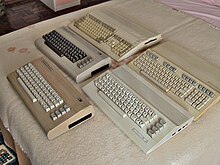


Avintage computer is an older computer system that is largely regarded as obsolete.
The personal computer has been around since approximately 1971.[1] But in that time, numerous technological revolutions have left generations of obsolete computing equipment on the junk heap. Nevertheless, in that time, these otherwise useless computers have spawned a sub-culture of vintage computer collectors, who often spend large sums to acquire the rarest of these items, not only to display but restore to their fully functioning glory,[2][3] including active software development and adaptation to modern uses. This often includes homebrew developers and hackers who add on, update and create hybrid composites from new and old computers for uses for which they were otherwise never intended.[4][5] Ethernet interfaces have been designed for many vintage 8-bit machines to allow limited connectivity to the Internet; where users can access user groups, bulletin boards, and databases of software.[6] Most of this hobby centers on those computers manufactured after 1960, though some collectors specialize in pre-1960 computers as well.[7]
The Vintage Computer Festival, an event held by the Vintage Computer Federation for the exhibition and celebration of vintage computers, has been held annually since 1997 and has expanded internationally.[8]
This section has multiple issues. Please help improve it or discuss these issues on the talk page. (Learn how and when to remove these template messages)
|
Micro Instrumentation and Telemetry Systems (MITS) produced the Altair 8800 in 1975. According to Harry Garland, the Altair 8800 was the product that catalyzed the microcomputer revolution of the 1970s.[9]

IMSAI produced a machine similar to the Altair 8800. It was introduced in 1975, first as a kit, and later as an assembled system.[10] The list price was $591 (equivalent to $3,392 in 2023) for a kit, and $931 (equivalent to $5,272 in 2023) assembled.[11]
Processor Technology produced the Sol-20. This was one of the first machines to have a case that included a keyboard; a design feature copied by many of later "home computers".

Southwest Technical Products Corporation (SWTPC) produced the 8-bit SWTPC 6800 and later the 16-bit SWTPC 6809 kits that employed the Motorola 68xx series microprocessors.
The earliest Apple Inc. personal computers, using the MOS Technology 6502 processors, are among some of the most collectible. They are relatively easy to maintain in an operational state thanks to Apple's use of readily available off-the-shelf parts.
Perhaps because of its friendly design and first commercially successful graphical user interface as well as its enduring Finder application that persists on the most current Macs, the Macintosh is one of the most collected and used vintage computers. With dozens of websites around the world, old Macintosh hardware and software are input into daily use. The Macintosh had a strong presence in many early computer labs, creating a nostalgia factor for former students who recall their first computing experiences.



There is little question that the current enthusiasm in personal computing was catalyzed by the introduction of the MITS Altair computer kit in January 1975.